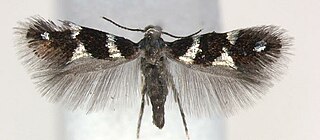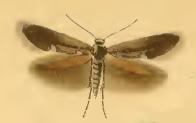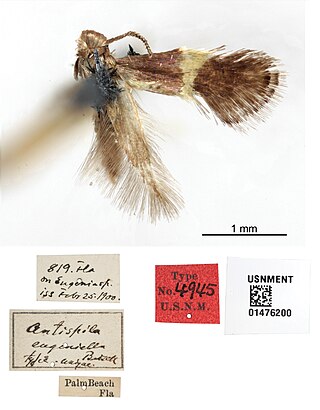
The Heliozelidae, commonly known as shield-bearer moths, are a family of small, day flying monotrysian moths distributed worldwide. The larvae of most heliozelid species are leaf miners who cut distinctive shield-shaped cases from the surface of the host leaf, hence the common name. Some species are considered pests of commercial crops such as grapevines, cranberries, and walnuts. The taxonomy of this family is poorly understood.
Varius ochnicola is the only species in the monotypic moth genus Varius of the family Nepticulidae. The genus was erected by Scoble in 1983. The species was first described by Vari in 1955. It is found in South Africa.

Antispila is a moth genus of the family Heliozelidae. It was described by Jacob Hübner in 1825.

Holocacista micrarcha is a moth of the family Heliozelidae. It was described by Edward Meyrick in 1926. It is found in India.

Heliozela is genus of moths of the family Heliozelidae, described by Gottlieb August Wilhelm Herrich-Schäffer in 1853.
Heliozela sobrinella is a moth of the Heliozelidae family. It was described by Deventer in 1904 as almost identical to Heliozela praeustella but a bit larger, with a wingspan of 6 mm. It is found on Java.
Heliozela brevitalea is a moth of the family Heliozelidae. It was described by Lee, Hirowatari and Kuroko in 2006 and is endemic to Japan (Honshu).
Heliozela glabrata is a moth of the family Heliozelidae. It was described by Lee, Hirowatari and Kuroko in 2006. It is found in Japan (Honshu).

Holocacista is a genus of moths of the family Heliozelidae. It was described by Walsingham and Durrant in 1909.

Pseliastis is genus of moths in the family Heliozelidae, first described by Edward Meyrick in 1897. Three species are currently described, all endemic to Australia.
Plesiozela is genus of moths in the family Incurvariidae. It was described by Ole Karsholt and Niels P. Kristensen in 2003 and initially placed in the family Heliozelidae.
Plesiozela patagonica is a species of moth in the family Incurvariidae. It was described by Ole Karsholt and Niels P. Kristensen in 2003 and can be found in Argentina.

Holocacista capensis is a moth of the family Heliozelidae. It was described by van Nieukerken and Geertsema in 2015. It is found in South Africa.

Aspilanta ampelopsifoliella is a species of moth in the family Heliozelidae. It is found in eastern North America. The larvae are leaf miners that feed on Virginia creeper and false Virginia creeper.

Heliozela eugeniella is a species of moth in the family Heliozelidae. It was described by August Busck in 1900 and is known only from Florida.

Aspilanta hydrangaeella is a species of moth in the family Heliozelidae. It is found in the United States. The larvae are leaf miners that feed on hydrangea plants.

Aspilanta oinophylla is a species of moth in the family Heliozelidae. It is native to North America and is an introduced species in Italy. The larvae are leaf miners that feed on several species of Vitaceae, including commercially important species of grapevine.

Aspilanta viticordifoliella is a species of moth in the family Heliozelidae. It is found in eastern North America. The larvae are leaf miners that feed on Virginia creeper, false Virginia creeper, and frost grape.

Aspilanta voraginella is a species of moth in the family Heliozelidae, first described by Annette Frances Braun in 1927. It is found in the United States. The larvae are leaf miners that feed on Vitis arizonica.

Aspilanta is a genus of very small moths in the family Heliozelidae that is native to North America. The larvae are leaf miners. Most Aspilanta species feed on Vitaceae with the exception of A. hydrangaeella and A. argentifera, which feed on species of hydrangea and Myricaceae respectively. The name of the genus is a partial anagram of Antispila.









